Today, gold coins are known to generations of Americans as little more than a tool for investment. Infomercials appear on television encouraging collectors and investors to purchase rare gold coins to protect their wealth, or simply build an impressive collection. However, for much of America’s history the gold coin was the nation’s standard legal currency. In fact, it wasn’t until 1933 that gold coins were removed from circulation as legal currency.
History of the Pre-1933 Gold Coins
The United States government minted its first gold coins in 1795 as the fledgling nation sought to establish its own hard currency and move its markets forward. Most of the coins from this time period have long since disappeared from the world, with any remaining pieces already in private hands or on display in museums. However, some of the nation’s most famous gold coins are still available to collectors today.
There was a significant increase in the production of gold coins following the discovery of gold in California in the 1840s. The gold rush brought a large influx of this precious metal to the US Treasury, and in turn, to the economy in the form of minted coins. These circulation coins were in circulation between 1838 and 1933, with varying circulation years for different coins.
End of the Gold Standard
Today, gold coins are no longer minted as standard legal currency because of the actions of the federal government in 1933. With the Great Depression at its height, President Franklin D. Roosevelt ordered all gold coins in circulation at the time to be collected by government agencies. The nation’s stockpile of gold coins (in circulation and out of circulation) was collected and melted down into gold bars.
The president’s decision was tied to economic forces. At this point in history, America was still on the gold standard. Every US Dollar in circulation was backed by gold in the nation’s reserves. When President Roosevelt made the decision to confiscate coins in 1933, one ounce of gold backed $20.67. Without the gold standard in place, one ounce of gold now backed $35.00. America has carried on since 1933 without the gold standard in place, resulting in no new gold coins minted since that year.
Pre-1933 U.S. Gold Coin Specifications
Today’s gold collector coins are often minted in .999 (or higher) pure gold. However, the pre-1933 US gold coins were minted at a slightly lower level of purity. The most common pre-1933s available to investors in the 21st century all have a purity of roughly 90% pure gold, or a total of .9675 troy ounces of pure gold. The purity of pre-1933 gold coins has never changed.
There are a total of eight pre-1933 US gold coins available to investors today. The coins were minted in four different denominations, with eight unique designs. The denominations included two $20 coins, two $10 coins, two $5 coins, and two coins valued at $2.50. The most common coin design was the gold Liberty Eagle coin, which was minted on coins at all four denomination levels. The most popular among collectors is the $20 Saint Gaudens, also known as the Walking Liberty gold coin.
U.S. Gold Coin Designs
As mentioned above, pre-1933 US gold coins are available in eight denominations. However, there are only three designs that were used on these coins. Liberty Eagle coins were minted for all denominations. The popular Indian Head design was used on three coins, and the Walking Liberty design was featured on just one coin. Below you’ll find a more in-depth look at each of the pre-1933 gold coins available to investors today.
Pre-1933 Liberty Gold Eagles
The Liberty Eagle gold coins feature a neoclassical design method that was common among American coins during the mid-19th century. Liberty Eagle coins feature a left-profile image of Lady Liberty on the obverse side. Lady Liberty’s image was inspired by Benjamin West’s painting Omnia Vincit Amor (Love Conquers All). Her hair is pulled back in a bun in the image, and she wears a crown with the word “Liberty” inscribed in it. Surrounding her image on the obverse side are 13 stars, representing the 13 original US colonies.
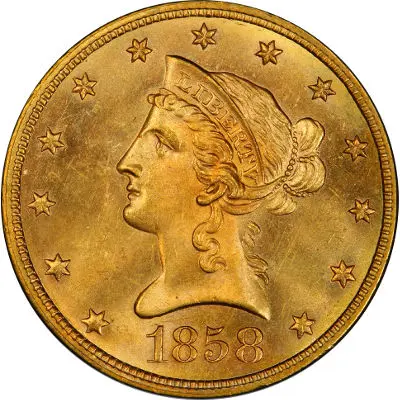
On the reverse side, the image of a bald eagle is featured with arrows in the clutches of one talon, and an olive branch in the other. The eagle is protected in front by a shield, and its image is surrounded by the engravings “United States of America” and its face value. The $10 and $5 gold Liberty Eagles are the oldest coins available, with production starting in 1838 and ending in 1908. The $2.50 gold Liberty Eagle had a production run of 1840 to 1907. The coins were produced at a number of US Mints across the country and featured only two slight variations in design over time. The only coins not to include a mint mark were those produced at the Philadelphia Mint.
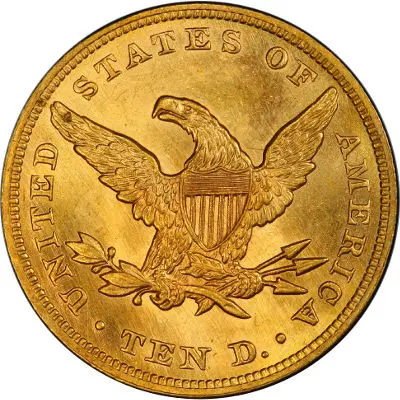
The $20 gold Liberty Double Eagle coin is the largest circulation pre-1933 gold coin available. It was minted much later than the other Liberty Eagle coins because of an excess of gold in the US Treasury following the California Gold Rush. Production of the $20 Liberty Double Eagle was authorized by congress in March 1849, and minting continued into the early 19th century.
The obverse design of Lady Liberty was similar to the other coins, but the reverse design of the eagle was based more upon the Great Seal of the United States than the other Liberty Eagle coins. With that said, the image still included the heraldic shield in front of an eagle clutching arrows and an olive branch.
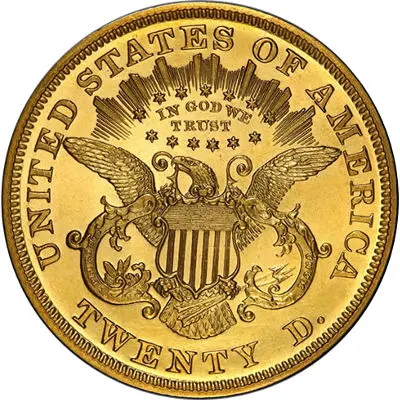
All of the Liberty Eagle coins were minted in .900 pure gold. The Liberty Double Eagles had three slight variations in design over time and, like the other Liberty coins, featured no mint mark for those coins produced at the Philadelphia Mint.
Pre-1933 Indian Head Gold Eagles
The Indian Head design was extremely common on early American coins. It had long been featured on lesser coinage, such as the nation’s early pennies. In the pre-1933 gold coin collection, Indian Head designs are available in $10, $5, and $2.50 denominations. The $10 and $5 Indian Head gold coins were the first to be introduced in this series, with the first coins minted in 1907. The $2.50 Indian Head was first minted in 1908. Production of the $2.50 and $5 Indian Heads ended in 1929. The $10 Indian Head was one of the last gold coins minted in the US when its production stopped in 1933.
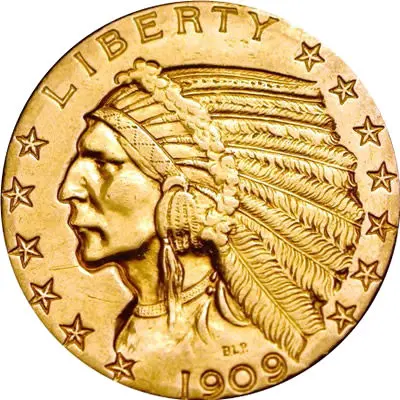
All Indian Head coins featured the same design on both the obverse and reverse sides. On the obverse side, a left-profile image of a Native American in full headdress is featured. The portrait is surrounded by 13 stars and the word “Liberty” above its head, with the year of minting engraved below. The reverse side features a unique take on the bald eagle. Rather than the heraldic imagery many investors and collectors are familiar with, the eagle is seen standing on top of an olive branch and arrows, symbolizing America’s military might and preparedness.
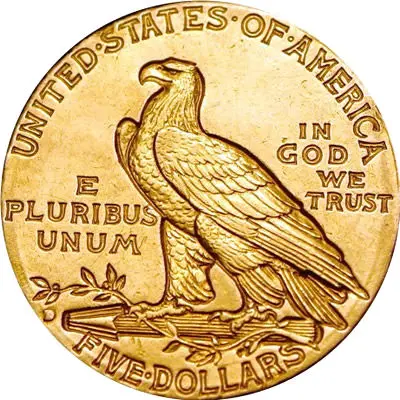
Pre-1933 Saint-Gaudens Gold Double Eagle
Perhaps the most beautiful coin ever minted in America is the $20 Saint-Gaudens Double Eagle coin. This coin was minted from 1907 right up to the final days of gold coin production in 1933. World renowned sculptor and artist Augustus Saint-Gaudens designed the image of a walking Lady Liberty that would be featured on the obverse side of the coin. In the image, Lady Liberty is seen emerging from the setting sun, with her torch in one hand to light the way and an olive branch in the other hand.
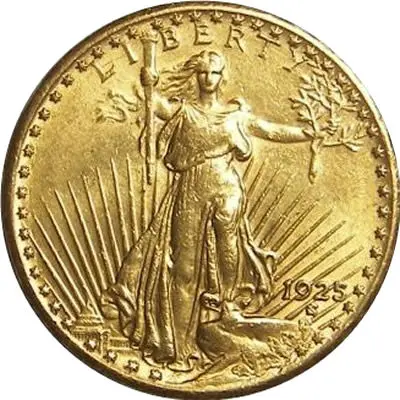
On the reverse side is an image of a bald eagle in flight. The rays of the sun are seen emanating from below the eagle, with the phrase “In God We Trust” engraved in the sun and “United States of America” engraved above the bird. While many of the other pre-1933 gold coins were struck at numerous mints, the $20 Liberty Double Eagle was only minted in Philadelphia, San Francisco, and Denver.
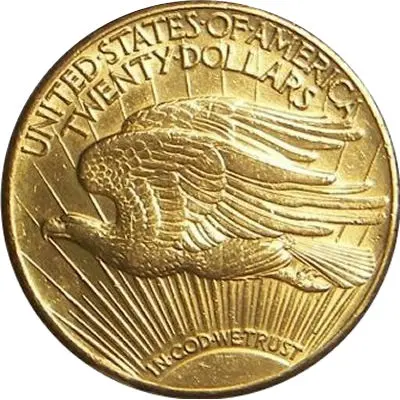
Buying U.S. Gold Coins (Pre-1933)
Pre-1933 US gold coins are extremely popular for two reasons. First and foremost, they are extremely rare. No gold coin has been minted since President Roosevelt’s declaration in 1933, meaning these coins are among the few surviving pieces left in the world today. It is estimated that only 1% of the coins mentioned above remain in existence today. Secondly, the designs on many of these coins are so famous that they hold tremendous intrinsic value to collectors.
Pricing Information
Pricing on these coins varies from around $600 to as high as millions of dollars, depending on several factors. While all the coins were minted with .900 pure gold, the heavier coins have a higher gold content in them. Additionally, the age of the coins also impacts the price. The Liberty Eagles minted in 1838 are much harder to find these days than the $20 Liberty Double Eagles that were minted in the early 20th century.
Coin Condition and Price
Other factors include the grade and condition of the coins (brilliant uncirculated, Mint-State grades compared to extra fine and poor for example) and mint location. For example, the $5 Liberty Eagle is the only coin from the pre-1933 collection that was minted at the US Mint facility in Dahlonega, Georgia.
Historical Value
Lastly, these coins appeal to consumers for different reasons. The $20 Liberty Double Eagle is popular due to its position as the largest circulation gold coin in American history, which gives it greater value as an investment tool. From a historical standpoint though, the $20 Saint-Gaudens is a favorite among collectors because it was both the last coin in the pre-1933 collection to be in circulation and because it is considered the most beautiful design.
Where to Buy Pre-1933 Gold Coins Online
You generally won’t find these coins at your neighborhood garage sale or flea market. The best place to shop is online via gold bullion and rare coin dealers. Companies like Golden Eagle Coins, who is a top U.S. gold coin dealer, has limited stockpiles of these rare coins, and offers you the peace of mind that comes with secure purchasing, grading, and certification of these rare gold coins.


